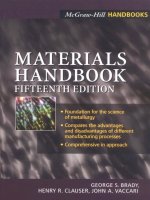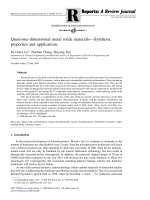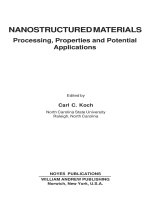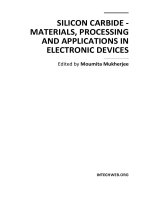- Trang chủ >>
- Khoa Học Tự Nhiên >>
- Vật lý
nanostructured materials. processing, properties and potential applications, 2002, p.625
Bạn đang xem bản rút gọn của tài liệu. Xem và tải ngay bản đầy đủ của tài liệu tại đây (8.59 MB, 625 trang )
Processing, Properties and Potential
Applications
Edited by
Carl C. Koch
North Carolina State University
Raleigh, North Carolina
NOYES PUBLICATIONS
WILLIAM ANDREW PUBLISHING
Norwich, New York, U.S.A.
NANOSTRUCTURED MATERIALS
Copyright © 2002 by Noyes Publications
No part of this book may be reproduced or
utilized in any form or by any means, elec-
tronic or mechanical, including photocopying,
recording or by any information storage and
retrieval system, without permission in writing
from the Publisher.
Library of Congress Catalog Card Number: 2001096788
ISBN: 0-8155-1451-4
Printed in the United States
Published in the United States of America by
Noyes Publications / William Andrew Publishing
13 Eaton Avenue
Norwich, NY 13815
1-800-932-7045
www.williamandrew.com
www.knovel.com
10 9 8 7 6 5 4 3 2 1
NOTICE
To the best of our knowledge the information in this publication is
accurate; however the Publisher does not assume any responsibility
or liability for the accuracy or completeness of, or consequences
arising from, such information. This book is intended for informational
purposes only. Mention of trade names or commercial products does
not constitute endorsement or recommendation for use by the Publisher.
Final determination of the suitability of any information or product
for use contemplated by any user, and the manner of that use, is the
sole responsibility of the user. We recommend that anyone intending
to rely on any recommendation of materials or procedures mentioned
in this publication should satisfy himself as to such suitability, and
that he can meet all applicable safety and health standards.
v
MATERIALS SCIENCE AND PROCESS TECHNOLOGY SERIES
Series Editors
Gary E. McGuire, Microelectronics Center of North Carolina
Stephen M. Rossnagel, IBM Thomas J. Watson Research Center
Rointan F. Bunshah, University of California, Los Angeles (1927–1999), founding editor
Electronic Materials and Process Technology
CHARACTERIZATION OF SEMICONDUCTOR MATERIALS, Volume 1: edited by Gary E.
McGuire
CHEMICAL VAPOR DEPOSITION FOR MICROELECTRONICS: by Arthur Sherman
CHEMICAL VAPOR DEPOSITION OF TUNGSTEN AND TUNGSTEN SILICIDES: by John E.
J. Schmitz
CHEMISTRY OF SUPERCONDUCTOR MATERIALS: edited by Terrell A. Vanderah
CONTACTS TO SEMICONDUCTORS: edited by Leonard J. Brillson
DIAMOND CHEMICAL VAPOR DEPOSITION: by Huimin Liu and David S. Dandy
DIAMOND FILMS AND COATINGS: edited by Robert F. Davis
DIFFUSION PHENOMENA IN THIN FILMS AND MICROELECTRONIC MATERIALS: edited by
Devendra Gupta and Paul S. Ho
ELECTROCHEMISTRY OF SEMICONDUCTORS AND ELECTRONICS: edited by John
McHardy and Frank Ludwig
ELECTRODEPOSITION: by Jack W. Dini
HANDBOOK OF CARBON, GRAPHITE, DIAMONDS AND FULLERENES: by Hugh O.
Pierson
HANDBOOK OF CHEMICAL VAPOR DEPOSITION, Second Edition: by Hugh O. Pierson
HANDBOOK OF COMPOUND SEMICONDUCTORS: edited by Paul H. Holloway and Gary
E. McGuire
HANDBOOK OF CONTAMINATION CONTROL IN MICROELECTRONICS: edited by Donald
L. Tolliver
HANDBOOK OF DEPOSITION TECHNOLOGIES FOR FILMS AND COATINGS, Second
Edition: edited by Rointan F. Bunshah
HANDBOOK OF HARD COATINGS: edited by Rointan F. Bunshah
HANDBOOK OF ION BEAM PROCESSING TECHNOLOGY: edited by Jerome J. Cuomo,
Stephen M. Rossnagel, and Harold R. Kaufman
HANDBOOK OF MAGNETO-OPTICAL DATA RECORDING: edited by Terry McDaniel and
Randall H. Victora
HANDBOOK OF MULTILEVEL METALLIZATION FOR INTEGRATED CIRCUITS: edited by
Syd R. Wilson, Clarence J. Tracy, and John L. Freeman, Jr.
HANDBOOK OF PLASMA PROCESSING TECHNOLOGY: edited by Stephen M. Rossnagel,
Jerome J. Cuomo, and William D. Westwood
HANDBOOK OF POLYMER COATINGS FOR ELECTRONICS, Second Edition: by James
Licari and Laura A. Hughes
HANDBOOK OF REFRACTORY CARBIDES AND NITRIDES: by Hugh O. Pierson
HANDBOOK OF SEMICONDUCTOR SILICON TECHNOLOGY: edited by William C. O’Mara,
Robert B. Herring, and Lee P. Hunt
HANDBOOK OF SEMICONDUCTOR WAFER CLEANING TECHNOLOGY: edited by Werner
Kern
vi Series
HANDBOOK OF SPUTTER DEPOSITION TECHNOLOGY: by Kiyotaka Wasa and Shigeru
Hayakawa
HANDBOOK OF THIN FILM DEPOSITION PROCESSES AND TECHNIQUES, Second Edition:
edited by Krishna Seshan
HANDBOOK OF VACUUM ARC SCIENCE AND TECHNOLOGY: edited by Raymond L.
Boxman, Philip J. Martin, and David M. Sanders
HANDBOOK OF VLSI MICROLITHOGRAPHY, Second Edition: edited by John N. Helbert
HIGH DENSITY PLASMA SOURCES: edited by Oleg A. Popov
HYBRID MICROCIRCUIT TECHNOLOGY HANDBOOK, Second Edition: by James J. Licari
and Leonard R. Enlow
IONIZED-CLUSTER BEAM DEPOSITION AND EPITAXY: by Toshinori Takagi
MOLECULAR BEAM EPITAXY: edited by Robin F. C. Farrow
NANOSTRUCTURED MATERIALS: edited by Carl. C. Koch
SEMICONDUCTOR MATERIALS AND PROCESS TECHNOLOGY HANDBOOK: edited by
Gary E. McGuire
ULTRA-FINE PARTICLES: edited by Chikara Hayashi, R. Ueda and A. Tasaki
WIDE BANDGAP SEMICONDUCTORS: edited by Stephen J. Pearton
Related Titles
ADVANCED CERAMIC PROCESSING AND TECHNOLOGY, Volume 1: edited by Jon G. P.
Binner
CEMENTED TUNGSTEN CARBIDES: by Gopal S. Upadhyaya
CERAMIC CUTTING TOOLS: edited by E. Dow Whitney
CERAMIC FILMS AND COATINGS: edited by John B. Wachtman and Richard A. Haber
CORROSION OF GLASS, CERAMICS AND CERAMIC SUPERCONDUCTORS: edited by
David E. Clark and Bruce K. Zoitos
FIBER REINFORCED CERAMIC COMPOSITES: edited by K. S. Mazdiyasni
FRICTION AND WEAR TRANSITIONS OF MATERIALS: by Peter J. Blau
HANDBOOK OF CERAMIC GRINDING AND POLISHING: edited by Ioan D. Marinescu, Hans
K. Tonshoff, and Ichiro Inasaki
HANDBOOK OF HYDROTHERMAL TECHNOLOGY: edited by K. Byrappa and Masahiro
Yoshimura
HANDBOOK OF INDUSTRIAL REFRACTORIES TECHNOLOGY: by Stephen C. Carniglia
and Gordon L. Barna
MECHANICAL ALLOYING FOR FABRICATION OF ADVANCED ENGINEERING MATERIALS:
by M. Sherif El-Eskandarany
SHOCK WAVES FOR INDUSTRIAL APPLICATIONS: edited by Lawrence E. Murr
SOL-GEL TECHNOLOGY FOR THIN FILMS, FIBERS, PREFORMS, ELECTRONICS AND
SPECIALTY SHAPES: edited by Lisa C. Klein
SOL-GEL SILICA: by Larry L. Hench
SPECIAL MELTING AND PROCESSING TECHNOLOGIES: edited by G. K. Bhat
SUPERCRITICAL FLUID CLEANING: edited by John McHardy and Samuel P. Sawan
vii
Contributors
Karl T. Aust
Department of Metallurgy and
Materials Science
University of Toronto
Toronto, Ontario
Canada
Ulrich Brossmann
Institut für Technische Physik
Technische Universität Graz
A-8010 Graz, Austria
Gan-Moog Chow
Department of Materials Science
National University of Singapore
Kent Ridge, Singapore
Philip Clapp
Institute of Materials Science
University of Connecticut
Storrs, CT
Uwe Erb
Department of Metallurgy and
Materials Science
University of Toronto
Toronto, Ontario
Canada
Jürgen Eckert
IFW Dresden
Institute of Metallic Materials
Dresden, Germany
Hans J. Fecht
Center for Energy Technology
Universitat Ulm
Ulm, Germany
Joanna Groza
Department of Chemical Engineering
and Materials Science
University of California
Davis, CA
viii Contributors
Akihisa Inoue
Institute for Materials Research
Tohoku University
Sendai, Japan
Carl C. Koch
Materials Science and Engineering
Department
North Carolina State University
Raleigh, NC
Lynn K. Kurihara
Naval Research Laboratory
Washington, D.C.
Maggy L. Lau
Department of Chemical and
Biochemical Engineering and
Materials Science
University of California
Irvine, CA
Enrique J. Lavernia
Department of Chemical and
Biochemical Engineering and
Materials Science
University of California
Irvine, CA
Akihiro Makino
Central Research Laboratory
Alps Electric Co. Ltd.
Nagaoka, Japan
Gino Palumbo
Integran Technologies, Inc.
Toronto, Ontario
Canada
Hans-Eckhardt Schaefer
Institut für Theoretische und
Angewandte Physik
Universität Stuttgart
D-70569 Stuttgart, Germany
Michel Trudeau
Hydro-Quebec Research Institute
Varennes, Quebec
Canada
Raphael Tsu
Department of Electrical and
Computer Engineering
University of North Carolina
Charlotte, NC
Julia R. Weertman
Department of Materials Science
and Engineering
Northwestern University
Evanston, IL
Roland Würschum
Institut für Technische Physik
Technische Universität Graz
A-8010 Graz, Austria
Qi Zhang
Department of Electrical and
Computer Engineering
University of North Carolina
Charlotte, NC
ix
Preface
INTRODUCTION
Nanostructure science and technology has become an identifiable, if
very broad and multidisciplinary, field of research and emerging applications
in recent years. It is one of the most visible and growing research areas in
materials science in its broadest sense. Nanostructured materials include
atomic clusters, layered (lamellar) films, filamentary structures, and bulk
nanostructured materials. The common thread to these various material
forms is the nanoscale dimensionality, i.e., at least one dimension less than
100 nm, more typically less than 50 nm. In some cases, the physics of such
nanoscale materials can be very different from the macroscale properties of
the same substance. The different, often superior, properties that can then
occur are the driving force behind the explosion in research interest in these
materials. While the use of nanoscale dimensions to optimize properties is not
new, as will be outlined below, the present high visibility and definition of the
field is mainly attributable to the pioneering work of Gleiter and coworkers
in the early 1980s.
[1]
They synthesized nanoscale grain size materials by the
in situ consolidation of atomic clusters. The studies of clusters preceded the
work by researchers such as Uyeda.
[2]
The International Technology Re-
search Institute, World Technology Division (WTEC), supported a panel
x Preface
study of research and development status and trends in nanoparticles,
nanostructured materials, and nanodevices during 1996–1998. The main
results of this study have been published.
[3]
This report attempted to cover
the very broad field of nanostructure science and technology and included
assessments of the areas of synthesis and assembly, dispersions and coatings,
high surface area materials, functional nanoscale devices, bulk nanostruc-
tured materials, and biologically related aspects of nanoparticles, nanostruc-
tured materials, and nanodevices. A conclusion of the report is that while
many aspects of the field existed well before it was identified as a field in the
last decade, three related scientific/technological advances have made it a
coherent area of research. These are:
1. New and improved synthesis methods that allow control of
the size and manipulation of the nanoscale “building blocks.”
2. New and improved characterization tools for study at the
nanoscale (e.g., spatial resolution, chemical sensitivity).
3. Better understanding of the relationships between nano-
structure and properties and how these can be engineered.
With the recent intense interest in the broad field of nanostructure
science and technology, a number of books, articles, and conference
proceedings have been published. A partial listing of these publications is
given in the bibliography, starting with the review of Gleiter in 1989. The
justification for yet another book in this expanding field is two-fold. Since
many areas of the field are moving rapidly with increased understanding
from both experiment and simulation studies, it would appear useful to record
another “snapshot” of the field. It will be assumed that by the time of
publication certain information may become obsolete, but at least most of the
background will still be useful to researchers and students. Second, since the
field is so broad, spanning the study of atomic clusters to bulk, and materials
from biological to metallic structures, the book has been designed to focus
mainly on those areas of synthesis, characterization, and properties relevant
to applications that require bulk, and mainly inorganic materials. An excep-
tion is the article by Tsu on electronic and optoelectronic materials. Before
a brief description of the chapters and organization of the book is presented,
a historical perspective will be given to suggest how the field has developed
and what new information has been provided by reaching the limit of the
nanoscale.
Preface xi
HISTORICAL PERSPECTIVE
Nanoscale microstructural features are not new, either in the natural
world or in materials engineering. There are examples of nanoscale
ferromagnetic particles found in microorganisms, e.g., 50 nm Fe
3
O
4
in the
organism A. magnetotactum.
[4]
A number of examples exist of improve-
ment in mechanical properties of structural materials when a fine micro-
structure was developed. Early in the last century, when “microstructures”
were revealed primarily with the optical microscope, it was recognized that
refined microstructures, for example, small grain sizes, often provide
attractive properties such as increased strength and toughness in structural
materials. A classic example of property enhancement due to a refined
microstructure—with features too small to resolve with the optical micro-
scope—was age-hardening of aluminum alloys. The phenomenon, discov-
ered by Alfred Wilm in 1906, was essentially explained by Merica,
Waltenberg, and Scott in 1919,
[5]
and the microstructural features respon-
sible were first inferred by the x-ray studies of Guinier and Preston in 1938.
With the advent of transmission electron microscopy (TEM) and sophisti-
cated x-ray diffraction methods, it is now known that the fine precipitates
responsible for age-hardening, in Al-4%Cu alloys, for example, are clusters
of Cu atoms—Guinier-Preston (GP) Zones—and the metastable partially
coherent θ´ precipitate.
[6][7]
Maximum hardness is observed with a mixture
of GPII (or θ´´ , coarsened GP zones) and θ´, with the dimensions of the θ´
plates, typically about 10 nm in thickness by 100 nm in diameter. Therefore,
the important microstructural feature of age-hardened aluminum alloys is
nanoscale.
Critical length scales often determine optimum properties which are
structure sensitive. Mechanical properties such as strength and hardness are
typical and as above, microstructural features such as precipitates or
dispersoids are most effective when their dimensions are nanoscale. In
ferromagnetic materials, the coercive force has been found to be a maximum
if spherical particles (e.g., Fe
3
C in Fe) which act as domain wall pinners have
a diameter about equal to the domain wall thickness, i.e., about 50 nm.
[8]
Similarly, in type II superconductors, it has been found that fluxoid pinning,
which determines the magnitude of the critical current density, is most
effective when the pinning centers typically have dimensions of the order of
the superconducting coherence length for a given material. For the high field
superconductors, the coherence length is usually about 10–20 nm and indeed
the commercial superconductors have pinning centers that approximate
xii Preface
these dimensions. In Nb
3
Sn, the grain boundaries are the major pinning sites
and optimum critical current densities are obtained when the grain sizes are
about 50 nm.
[9]
Many other examples could be given of the long term use
of nanoscale materials in fields such as catalysis.
ORGANIZATION
The scientific/technological advances that have focused the field into
a broad but coherent field were given above. In this book, the new or
improved synthesis methods that are one of the cornerstones of the field will
be reviewed in Part I. In Part II, selected properties of nanostructured
materials will be covered. Potential applications of nanostructured materials
will be described as appropriate throughout the book.
In Ch. 1, Chow and Kurihara present an overview of the chemical
synthesis and processing of nanostructured particles, films, and coatings.
This includes particles from all materials classes, that is metals, ceramics,
organic materials, etc. The chemical methods described include aqueous,
non-aqueous, sonochemical, precursor, organometallic, hydrolysis, hydro-
thermal, and sol-gel methods. Other methods discussed are host-derived
hybrid materials, surfactant membrane mediated synthesis, and a variety of
films and coatings.
Lau and Lavernia describe the thermal spray processing of nanostruc-
tured materials. This method has the potential for early commercialization of
coatings with nanocrystalline microstructures and superior properties. The
chapter provides an overview of thermal sprayed coatings produced from
nanocrystalline feedstock powders. The various routes for producing the
nanocrystalline feedstock powders are discussed. The structure and prop-
erties of the nanocrystalline coatings are considered in the light of retention
of a nanoscale microstructure during processing. A review of theoretical
models to predict and optimize the thermal spraying parameters for opti-
mized coatings is presented.
Fecht considers in his chapter the preparation of nanostructured
materials and composites by solid-state processing methods which involve
plastic mechanical deformation. The use of ball-milling of powders has
become a popular method of producing nanocrystalline materials because of
the simplicity of the equipment and the possibility to scale-up from laboratory
to tonnage quantities of material. Fecht describes the use of mechanical
attrition for production of nanocrystalline materials in a wide variety of
Preface xiii
materials including metals, ceramics, polymer blends, and composites. The
stability at elevated temperatures is discussed for the nanocrystalline
microstructures made by these methods. The production of nanocrystalline
materials by severe plastic deformation induced by methods other than
milling are also discussed. Such methods are bulk plastic deformation, rolling,
and friction.
A major problem with nanocrystalline materials made in particulate
form is the requirement for consolidation into bulk for most applications. The
consolidation must provide theoretical density and strong particulate bonding
while not unduly coarsening the nanocrystalline microstructure. Groza
reviews powder consolidation methods in her chapter. She reviews the
thermodynamics and kinetics of nanopowder densification. This includes the
driving force for densification, surface energy, sintering mechanisms,
activation energies, and scaling laws. The role of surface contamination with
impurities during sintering is emphasized. The processes of cold compaction,
pressureless and pressure-assisted sintering, and full densification methods
are described with the goal of maintaining the nanoscale microstructure.
While Chs. 1 and 3 describe processing methods for nanocrystalline
materials that result in particulates that require subsequent compaction, i.e.,
“two-step processing,” there are one-step processing methods available that
eliminate the need for compaction with its attendant problems. A notable and
commercially attractive one-step method is electrodeposition. Erb, Aust, and
Palumbo describe the process, structure, and properties of nanostructured
materials made by electrodeposition. While electrodeposition is an old
industrial process, it has only been in the last decade or so that it has been
systematically applied to the synthesis of nanocrystalline materials. This
chapter describes the processing methods as well as the structure and
properties of the electrodeposited nanostructured materials. Comparisons
are presented for the structure and properties with those of nanostructured
materials made by other methods. Examples of industrial applications of
electrodeposited nanostructured materials are given.
Clapp reviews the growing area of computer simulation of
nanomaterials. This comprises “virtual processing,” so is placed in Part I.
Because of the difficulties involved with preparation of artifact-free nanoc-
rystalline materials of the smallest grain sizes (<25 nm), simulation studies
can be of great benefit and complement experimental work. This review
begins with studies of the stability of individual isolated nanoparticles, then
moves to a variety of subjects related to interface properties in nanomaterials,
and finally covers simulations of three-dimensional nanograin materials.
xiv Preface
Part II of the book deals with selected properties of nanocrystalline
materials. Diffusion in nanocrystalline materials is reviewed by Wurschum,
Brossmann, and Schaefer. The results of diffusion studies of nanocrystal-
line metals are presented and discussed. Correlations between diffusion and
grain growth, that is nanostructure stability, are described. Examples for
specific systems include the Fe-based soft magnetic “Finemet” alloys,
hydrogen diffusion in nanocrystalline metals, and
18
O diffusion in nanocrys-
talline ZrO
2
. The latter is compared with diffusion studies in other nanocrys-
talline ceramics.
Trudeau presents a review of recent developments for nanocrystalline
materials in gas reactive applications. Three research areas are discussed.
They are:
1. Catalysis and electrocatalysis
2. Semiconductor gas sensors
3. Hydrogen storage materials
The advantages of nanocrystalline materials are described in each case.
The magnetic properties of nanocrystalline materials provide the
possibility of near-term application with, in particular, outstanding soft-
magnetic properties. Inoue and Makino review examples of the important
nanocrystalline soft magnetic materials. These have been developed by
either partial crystallization of rapidly solidified (melt spun) amorphous
precursors, or by sputtering of nanocrystalline/amorphous films. The sys-
tems described include Fe-M-B (M = Zr, Hf, or Nb) and Fe-M-O (M = Zr,
Hf, or rare earth element). The improvement of the soft magnetic properties
by alloying additions is discussed. A number of potential applications of these
superior soft magnetic materials are presented.
Mechanical properties of nanocrystalline materials have been studied
extensively since early work suggested revolutionary improvements in both
strength and ductility. The state-of-the-art in this area is reviewed by
Weertman. This review describes the various models that have been
proposed for mechanical behavior of nanocrystalline materials. The impor-
tant subject of the microstructural characterization of nanocrystalline
materials is covered. Then the experimentally determined deformation
behavior of nanostructured materials is presented.
While the results of mechanical property studies have been dis-
appointing so far on single phase nanocrystalline materials, there appears
to be promise for multiphase nanocrystalline materials. The structure,
formation, and mechanical behavior of two-phase nanostructured materials
Preface xv
are reviewed by Eckert. The methods and process variables used to produce
bulk two-phase nanostructured materials are described. The mechanical
behavior of such materials is then discussed for both room and elevated
temperature testing. In some cases, it appears that multiphase nanocrystal-
line materials can offer combinations of both high strength and ductility
compared to single phase materials in which ductility is very limited for grain
sizes of about 25 nm or less.
The subject of “functional” nanostructured materials for electronic and
optoelectronic materials is a large and important area. While this field is not
stressed in this book, it was felt that a chapter outlining some of the important
features of this area should be included. Tsu and Zhang give examples of
functional nanocrystalline materials, that is, typically thin films or quantum
dots for electronic or optoelectronic applications. An in-depth treatment of
several topics related to silicon semiconductors is given. This includes the
physics of nanostructured materials which covers the dielectric constant, the
capacitance, doping and exiton binding energies of a nanoparticle. In
addition, possible devices requiring nanoscale features are described. Such
devices are light emitting diodes (LEDs) and quantum field effect transistors
(QD-FETs).
REFERENCES
1. Gleiter, H., Progress in Materials Science, 33:223–315 (1989)
2 Uyeda, R., Progress in Materials Science, 35:1–96 (1991)
3. Siegel, R. W., Hu, E., and Roco, M. C., (eds.), Nanostructure Science and
Technology, Kluwer Academic Publishers, Dordrecht, Netherlands (1999)
4. Kirschvink, J. L., Koyayashi-Kirschvink, A., and Woodford, B. J., Proc.
Nat’l. Acad. Sci., USA, 89:7683–7687 (1992)
5. Mehl, R. F., and Cahn, R. W., Historical Development, Physical Metallurgy,
3
rd
ed., pp. 1–35, North Holland (1983)
6. Silcock, J. M., Heal, T. J., and Hardy, H. K., J. Institute of Metals, 82:239
(1953–54)
7. Cohen, J. B., Metall. Trans. A., 23A:2685 (1992)
8. Swisher, J. H., English, A. T., and Stoffers, R. C., Trans. ASM, 62:257 (1969)
9. Scanlan, R. M., Fietz, W. A., and Koch, E. F., J. Appl. Phys., 46:2244
(1975)
xvi Preface
BIBLIOGRAPHY
Gleiter, H., Nanocrystalline Materials, Progress in Materials Science,
33:223–315 (1989)
Siegel, R. W., Nanostructured Materials—Mind Over Matter,
Nanostructured Materials, 3:1 (1993)
Hadjipanayis, G. C., and Siegel, R. W., Nanophase Materials: Synthesis-
Properties-Appplications, Kluwer Press, Dordrecht, Netherlands (1994)
Siegel, R. W., Nanophase Materials, in: Encyclopedia of Applied Physics,
(G. L. Trigg, ed.), 11:1–27, VCH, Weinheim (1994)
Gleiter, H., Nanostructured Materials: State of the Art and Perspectives,
NanoStructured Materials, 6:3 (1995)
Edelstein, A. S., and Cammarata, R. C., (eds.), Nanomaterials: Synthesis,
Properties, and Appplications, Institute of Physics, Bristol (1996)
Carl Koch October, 2001
Raleigh, North Carolina
xvii
Contents
Part I
Processing
1 Chemical Synthesis and Processing of Nanostructured
Powders and Films 3
Gan-Moog Chow and Lynn K. Kurihara
1.0 INTRODUCTION 3
2.0 PARTICLES 5
2.1 Nucleation and Growth 5
2.2 Stable Dispersion and Agglomeration 6
2.3 Metals, Intermetallics, Alloys, and Composites 10
2.4 Ceramics 20
2.5 Host-Derived Hybrid Materials 24
2.6 Stabilized Dispersions 29
2.7 Surfactant Membrane Mediated Synthesis 30
3.0 FILMS AND COATINGS 34
3.1 Metals 34
3.2 Ceramics 36
4.0 SUMMARY 39
REFERENCES 40
xviii Contents
2 Thermal Spray Processing of Nanocrystalline
Materials 51
Maggy L. Lau and Enrique J. Lavernia
1.0 INTRODUCTION 51
2.0 SYNTHESIS OF NANOCRYSTALLINE POWDER FOR
THERMAL SPRAYING 53
3.0 THERMAL SPRAYING 57
3.1 Coating Characteristics 58
4.0 MODELING 64
4.1 Particle Dynamics 65
4.2 In-Flight Heat Transfer 65
4.3 Oxidation Behavior 67
5.0 CONCLUSIONS 68
ACKNOWLEDGMENTS 69
REFERENCES 69
3 Nanostructured Materials and Composites
Prepared by Solid State Processing 73
Hans J. Fecht
1.0 INTRODUCTION AND BACKGROUND 73
2.0 PHENOMENOLOGY OF NANOSTRUCTURE FORMATION 75
3.0 HIGH-ENERGY BALL MILLING AND MECHANICAL
ATTRITION 77
3.1 Examples 77
3.2 Mechanism of Grain Size Reduction 85
3.3 Property—Microstructure Relationships 91
4.0 PHASE STABILITY AT ELEVATED TEMPERATURES 95
5.0 SEVERE PLASTIC DEFORMATION 99
5.1 General 99
5.2 Cold Rolling of Thin Sheets 100
5.3 Friction-Induced Surface Modifications 102
6.0 SUMMARY AND OUTLOOK 106
ACKNOWLEDGEMENTS 107
REFERENCES 107
Contents xix
4 Nanocrystalline Powder Consolidation Methods 115
Joanna R. Groza
1.0 INTRODUCTION 115
2.0 SPECIFIC ISSUES IN THE DENSIFICATION OF
NANOCRYSTALLINE POWDERS 117
2.1 Thermodynamic and Kinetic Effects 117
2.2 Sintering Mechanisms 120
2.3 Impurity Role 127
2.4 Green Density of Nanopowders 129
2.5 Pore Size and Its Effects on the Densification Behavior 137
2.6 Grain Growth 141
3.0 METHODS FOR FULL DENSIFICATION OF NANOPOWDERS 144
3.1 Characterization of Nanomaterials Densification: Density
and Grain Size Measurements 144
3.2 Conventional Sintering 146
3.3 Pressure Effects in Nanopowder Consolidation 150
3.4 Pressure-Assisted Consolidation Methods 155
3.5 Non-Conventional Sintering Methods 158
4.0 SUMMARY 160
ACKNOWLEDGMENTS 161
REFERENCES 161
5 Electrodeposited Nanocrystalline Materials 179
Uwe Erb, Karl T. Aust, and Gino Palumbo
1.0 INTRODUCTION 179
2.0 SYNTHESIS OF NANOSTRUCTURED MATERIALS BY
ELECTRODEPOSITION 179
3.0 STRUCTURE OF NANOCRYSTALLINE METAL
ELECTRODEPOSITS 183
4.0 PROPERTIES 187
4.1 Mechanical Properties 187
4.2 Corrosion Properties 193
4.3 Hydrogen Transport and Activity 197
4.4 Magnetic Properties 200
4.5 Thermal Stability 202
4.6 Thermal Expansion and Heat Capacity 205
4.7 Electrical Properties 207
xx Contents
5.0 APPLICATIONS 208
5.1 Structural Applications 209
5.2 Functional Applications 211
5.3 Coating Applications 214
REFERENCES 215
6 Computer Simulation of Nanomaterials 223
Philip C. Clapp
1.0 INTRODUCTION 223
2.0 NANOPARTICLES 226
2.1 Phase Stability (Liquid, Amorphous, and Crystalline) 226
2.2 Surface Properties 227
3.0 NANOCONTACTS 228
3.1 Adhesion 228
3.2 Friction 229
3.3 Electrical Conductance 230
4.0 NANOFILMS 231
4.1 Formation: General Methods 231
4.2 Formation: Liquid Droplet and Cluster Beam Deposition 231
4.3 Formation: Vapor and Molecular Beam Deposition 232
4.4 Mechanical Instabilities and Defects in Thin Films 233
4.5 Chemical Instabilities and Phase Separation 233
4.6 Free Surfaces 236
5.0 NANOGRAIN MATERIALS 238
5.1 Grain Boundary Structure and Energy 238
5.2 Grain Boundary Segregation Effects 239
5.3 Sintering 241
5.4 Recrystallization 243
5.5 Grain Growth 245
5.6 Strength 247
REFERENCES 248
Contents xxi
Part II
Properties
7 Diffusion in Nanocrystalline Materials 267
Roland Würschum, Ulrich Brossmann, and Hans-
Eckhardt Schaefer
1.0 INTRODUCTION 267
2.0 MODELING OF INTERFACE DIFFUSION 269
3.0 DIFFUSION IN GRAIN BOUNDARIES OF METALS 270
4.0 DIFFUSION IN NANOCRYSTALLINE METALS 271
4.1 Results and Discussion 271
4.2 Correlation Between Diffusion and Crystallite Growth 279
5.0 DIFFUSION IN THE NANOCRYSTALLINE ALLOY
FINEMET 282
6.0 DIFFUSION OF HYDROGEN IN NANOCRYSTALLINE
METALS AND ALLOYS 286
7.0 DIFFUSION IN NANOCRYSTALLINE CERAMICS 287
ACKNOWLEDGMENT 291
REFERENCES 291
8 Nanostructured Materials for Gas Reactive
Applications 301
Michel L. Trudeau
1.0 INTRODUCTION 301
2.0 CATALYSIS AND ELECTROCATALYSIS 302
2.1 Impact of Structure on Catalysis and Electrocatalysis
Processes 303
2.2 Nanostructure Design 306
3.0 GAS SENSORS 317
3.1 Impact of Nanostructure on the Physical Principles of
Semiconductor Sensors 318
3.2 Nanostructured Design 325
4.0 HYDROGEN STORAGE 333
4.1 Properties of Hydrogen Storage Compounds 334
4.2 Nanostructured Design 336
xxii Contents
5.0 CONCLUSION 341
ACKNOWLEDGEMENTS 343
REFERENCES 343
9 Magnetic Properties Of Nanocrystalline
Materials 355
Akihisa Inoue and Akihiro Makino
1.0 INTRODUCTION 355
2.0 Fe-M-B (M = Zr, Hf, or Nb) AMORPHOUS ALLOYS
AND THEIR CRYSTALLIZATION-INDUCED
NANOSTRUCTURE 356
3.0 SOFT MAGNETIC PROPERTIES AND STRUCTURAL
ANALYSES OF Fe-M-B (M = Zr, Hf, or Nb)
NANOCRYSTALLINE TERNARY ALLOYS 360
4.0 IMPROVEMENT OF SOFT MAGNETIC PROPERTIES
BY THE ADDITION OF SMALL AMOUNTS OF SOLUTE
ELEMENTS 369
5.0 IMPROVEMENT OF HIGH-FREQUENCY PERMEABILITY
BY THE DISSOLUTION OF OXYGEN INTO THE
SURROUNDING AMORPHOUS PHASE 376
5.1 As-Sputtered Structure 376
5.2 Magnetic Properties 381
6.0 APPLICATIONS 389
7.0 CONCLUSIONS 393
REFERENCES 394
10 Mechanical Behavior of Nanocrystalline Metals 397
Julia R. Weertman
1.0 INTRODUCTION 397
2.0 MODELS OF MECHANICAL BEHAVIOR OF
NANOCRYSTALLINE MATERIALS 398
3.0 CHARACTERIZATION OF NANOCRYSTALLINE METALS 405
4.0 MECHANICAL BEHAVIOR 409
5.0 CONCLUSIONS 418
REFERENCES 418
Contents xxiii
11 Structure Formation and Mechanical Behavior
of Two-Phase Nanostructured Materials 423
Jürgen Eckert
1.0 INTRODUCTION 423
2.0 METHODS OF PREPARATION 425
2.1 Rapid Solidification Techniques 425
2.2 Mechanical Attrition 427
2.3 Devitrification of Metallic Glasses 432
3.0 PHENOMENOLOGY OF NANOSTRUCTURE FORMATION
AND TYPICAL MICROSTRUCTURES 438
3.1 Rapidly Solidified Materials 439
3.2 Conventional Solidification and Devitrification of Bulk
Samples 458
3.3 Mechanically Attrited Powders 468
4.0 MECHANICAL PROPERTIES AT ROOM AND
ELEVATED TEMPERATURES 482
4.1 Al-Based Two-Phase Nanostructured Alloys 483
4.2 Mg-Based Amorphous and Nanostructured Alloys 488
4.3 Zr-Based Alloys 494
4.4 Mechanically Attrited Composites 502
5.0 SUMMARY AND OUTLOOK 511
ACKNOWLEDGMENTS 513
REFERENCES 513
12 Nanostructured Electronics and Optoelectronic
Materials 527
Raphael Tsu and Qi Zhang
1.0 INTRODUCTION 527
2.0 PHYSICS OF NANOSTRUCTURED MATERIALS 528
2.1 Quantum Confinement: Superlattices and Quantum Wells 528
2.2 Dielectric Constant of Nanoscale Silicon 529
2.3 Doping of a Nanoparticle 531
2.4 Excitonic Binding and Recombination Energies 533
2.5 Capacitance in a Nanoparticle 535
2.6 Structure, Bonds, and Coordinations of Si Nanostructure:
Porous Si and Si Clusters 538
xxiv Contents
3.0 APPLICATIONS 541
3.1 Porous Silicon 541
3.2 Photoluminescence in nc-Si/SiO
2
Superlattices 543
3.3 Luminescence from Clusters 545
3.4 Hetero-Epilattice Si/O Superlattice 546
3.5 Amorphous Silicon/Oxide Superlattice 550
3.6 nc-Si in an Oxide Matrix 550
3.7 Electronic Applications of HEL-Si/O Superlattices 552
3.8 Single Electron Transistor 554
3.9 Quantum Dot Laser 559
4.0 EPILOGUE 562
ACKNOWLEDGMENTS 563
REFERENCES 563
Index 569
1
Part I
Processing
3
1.0 INTRODUCTION
The performance of materials depends on their properties. The
properties in turn depend on the atomic structure, composition, microstruc-
ture, defects, and interfaces, which are controlled by thermodynamics and
kinetics of the synthesis. A current paradigm of synthesizing and processing
of advanced materials emphasizes the tailored assembly of atoms and
particles, from the atomic or molecular scale to the macroscopic scale.
Nanostructured materials, often characterized by a physical dimension
of 1–100 nm (such as grain size) and a significant amount of surfaces and
interfaces, have been attracting much interest because of their demon-
strated or anticipated unique properties compared to conventional materi-
als. Nanostructured materials can be made by attrition of parent coarse-
grained materials using the top-down approach from the macroscale to the
nanoscale, or conversely, by assembly of atoms or particles using the
bottom-up approach. The control of arrangement of atoms from the nanoscale
to the macroscale is indeed the strength of materials chemistry. Therefore,
1
Chemical Synthesis and
Processing of
Nanostructured Powders
and Films
Gan-Moog Chow* and Lynn K. Kurihara**
*Formerly at Naval Research Laboratory, Washington, DC, USA.
**Also at Potomac Research International, Fairfax, VA, USA.
4 Chapter 1 - Chemical Synthesis and Processing
it is not surprising that increasing attention has been paid to the chemical
synthesis and processing of nanostructured materials.
[1]–[8]
Chemical reactions for material synthesis can be carried out in the
solid, liquid, or gaseous state.
[9]
The more conventional solid-state syn-
thetic approach is to bring the solid precursors (such as metal oxides or
carbonates) into close contact by grinding and mixing, and to subsequently
heat treat this mixture at high temperatures to facilitate diffusion of atoms
or ions in the chemical reaction. The diffusion of atoms depends on the
temperature of the reaction and grain boundary contacts. The transport
across grain boundaries is also affected by impurities and defects located
there. The mixing and grinding steps are usually repeated throughout the
heat cycle, and generally involve a great deal of effort to mix materials at
the nanoscale and also to prepare fresh surfaces for further reactions. For
systems that do not contain means to inhibit grain growth (such as grain
growth inhibitors and immiscible composites), grain growth at elevated
temperature reactions leads to solids with large grain size.
Compared to solid-state synthesis, diffusion of matter in the liquid
or gas phase is typically and advantageously many orders of magnitude
larger than in the solid phase, thus the synthesis of nanostructured materials
can be achieved at lower temperatures. Lower reaction temperatures also
discourage detrimental grain growth. Many materials can be synthesized in
aqueous or nonaqueous solutions. For example, water is one of the best
known and most common solvents. There are three general classes of
aqueous reactions: acid/base reaction, precipitation, and reduction/oxida-
tion (redox). In basic chemistry terms, starting materials of a chemical
reaction are called the reactants and the material to which the reactants are
converted the products. The reactants can be solids, liquids, or gases in any
combination, in the form of single elements or multi-component com-
pounds. A multi-element compound is usually called a precursor. In a
precursor, the components of the final product are in a “mixture” with
atomic scale mixing. Many precursors can be prepared by precipitation
reactions. In precipitation reactions, solutions of two or more electrolytes
are mixed and an insoluble precipitate or a gelatinous precipitate forms.
In chemical synthesis of materials, one should always use
caution when handling reactants and precursors, reaction by-products and
post-reaction wastes, particularly when complex and hazardous chemi-
cals are involved. Special procedures may be required to remove any
entrapped impurities from the products and to avoid post-synthesis con-
tamination. Although many laboratory-scale reactions can be scaled up to
economically produce large quantities of materials, the laboratory-scale









